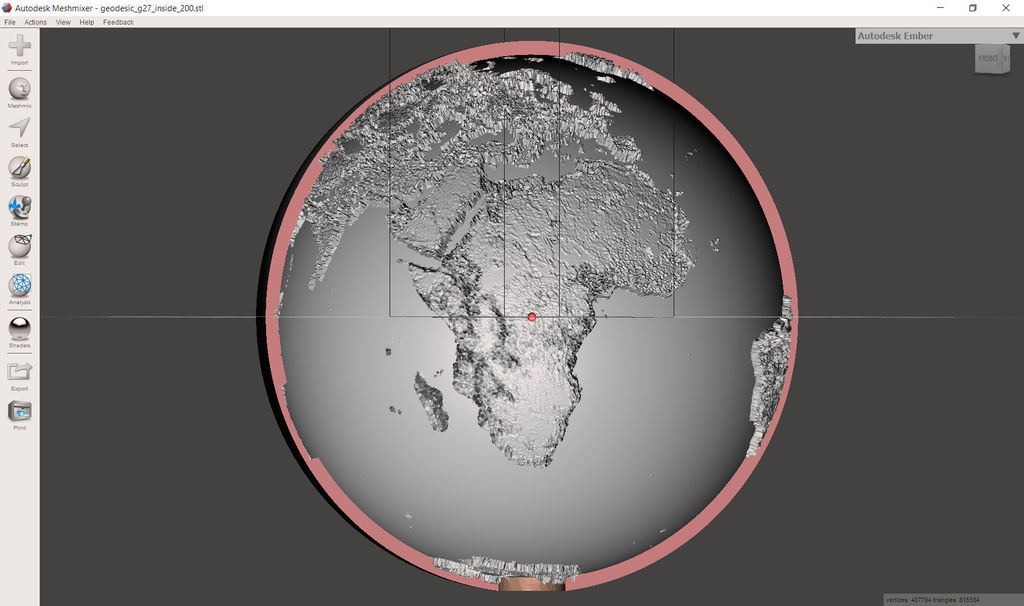
Geodesic Spherical Lithophane
prusaprinters
<p>This is a python script to map a grayscale image as a height map onto the inside or outside of a hollow sphere. The result is a spherical lithophane.</p> <p>It is an updated version of <a href="https://www.thingiverse.com/thing:2770219">my previous Thing</a>.</p> <p>The first photo shows the progress of geodesic_g27_inside_200_drilled.stl after 6h of printing on my Wanhao i3.</p> <h3>Print Settings</h3> <p><strong>Printer:</strong></p> <p>Wanhao i3 v2</p> <p><strong>Rafts:</strong></p> <p>No</p> <p><strong>Supports:</strong></p> <p>Yes</p> <p><strong>Resolution:</strong></p> <p>0.2</p> <p><strong>Infill:</strong></p> <p>100%</p> <h3>How I Designed This</h3> <p><strong>New approach</strong></p> <p>In <a href="https://www.thingiverse.com/thing:2770219">my previous Thing</a>, I based the sphere on spherical coordinates using a rectangular mesh of latitude and longitude angles. The disadvantage of that approach is the unnecessarily dense mesh it generates at the poles of the globe.</p> <p>Not only does this result in a lot of vertices and faces which need to be handled by the slicer, even the script generating the mesh could easily run for hours in order to get a decent equatorial resolution.</p> <p>In order to circumvent this problem I remembered an object class in the virtual 3D world ov the <a href="http://www.povray.org/">raytracer POV-Ray</a> which I played around with almost 20 years ago: <a href="https://www.sciencetronics.com/geocities/povray/geodesic.html">the geodesic sphere</a>.</p> <p><strong>Meet the Geodesic Sphere</strong></p> <p>A spherical object can be created if you start with a regular <a href="https://en.wikipedia.org/wiki/Icosahedron">icosahedron</a>. As one of the five Platonic solids it consists of 20 equilateral triangles.</p> <p>By subsequent subdivision of each of the faces into smaller triangles you will get smoother and smoother approximations to a sphere. Geodesics are widely used in architecture to construct round dome shapes - often from glass panes and metal struts.</p> <p><strong>Original idea</strong></p> <p>A couple of weeks ago I saw the YouTube video where<em>RCLifeOn</em> presented his <a href="https://youtu.be/YjkP1BcwLNI">spherical lithophane globe</a>. He used Autodesk 3ds Max to design the object, where he placed the height map on the outside of the globe, but I immediately wondered how it would look like when the height map was hidden inside the globe.</p> <p>RCLifeOn has also posted his globe here on <a href="https://www.thingiverse.com/thing:2761284">Thingiverse</a>.</p> <p><strong>Free and open source?</strong></p> <p>Not having access to this piece of software I researched if I could get a similar result using free tools. My favorite OpenSCAD does not (yet?) support mapping of bitmap files onto non-flat surfaces, so I had to look further.</p> <p>I quickly found an example on how to create an .stl file in python and started to experiment. My first output was a simple cube, before I put all pieces together:</p> <ul> <li>scaling an image</li> <li>creating a sphere</li> <li>creating a second sphere</li> <li>putting the two spheres into each other</li> <li>modifying the thickness of the wall by means of the map</li> </ul> <p><strong>Implementation</strong></p> <p>The map I use is the free <a href="https://asterweb.jpl.nasa.gov/gdem.asp">height map image of the world</a> by NASA. I now added the map itself and a modified version with a gamma setting of 2.7 which might give a better contrast between the oceans and continents.</p> <p>In the Python script itself you can modify a couple of things</p> <ul> <li>the outer diameter of the sphere</li> <li>the number of subdivisions of the geodesic object, starting at 10 pixels around the equator for a frequency of 1, this number can be increased e.g. to about 2000 pixels around the equator for a frequency of 200</li> <li>the thickness of the wall for the black portions of the mapped image</li> <li>the depth of the carving from the outside in</li> <li>the depth of the carving from the inside out</li> <li>the filename of the image to be carved out of the wall of the sphere</li> </ul> <p><strong>The files</strong></p> <p>the included files are:</p> <p>// the main script geodesic_mapped_double.py</p> <p>// a 120 mm sphere with the world on the inside at freq=200 // wall thickness 3 mm, carving depth 2.2 mm geodesic_g27_inside_200.stl</p> <p>// - the same sphere with a 15 mm diameter hole at the south pole geodesic_g27_inside_200_drilled.stl</p> <p>// a 120 mm sphere with the world on the outside at freq=200 // wall thickness 3 mm, carving depth 2.2 mm geodesic_g27_outside_200.stl</p> <p>// - the same sphere with a 15 mm diameter hole at the south pole geodesic_g27_outside_200_drilled.stl</p> <p>// checkerboard patterned sphere - carved from the outside, freq=100 geodesic_test_outside_100.stl // checkerboard patterned sphere - carved from the outside, freq=100 geodesic_test_inside_100.stl // checkerboard patterned sphere - carved from the outside, freq=100 geodesic_test_inoutside_100.stl</p> <p>// the same three spheres cut open geodesic_test_outside_100_cut.stl geodesic_test_inside_100_cut.stl geodesic_test_inoutside_100_cut.stl</p> <p>geodesic_demo_1.stl // just a geodesic object, freq=1 geodesic_demo_2.stl // freq=2 geodesic_demo_4.stl // freq=3 geodesic_demo_3.stl // freq=4 geodesic_demo_5.stl // freq=5 geodesic_demo_6.stl // freq=6</p> Category: Sculptures
With this file you will be able to print Geodesic Spherical Lithophane with your 3D printer. Click on the button and save the file on your computer to work, edit or customize your design. You can also find more 3D designs for printers on Geodesic Spherical Lithophane.
